I have been toying with the idea of using a 240Volt water heater powered with the excess PV from my inverter dump load to store and release heat(more slowly than a resistive heater) in my workshed/power house.
My idea is to fill the system with propylene glycol and heat and pump that through a small heat exchanger. The reason to use antifreeze is that this would be a closed system and would not always get enough power to keep water above freezing. I don't need it to heat the shed up a lot, just keep it about freezing/more stable temperature in winter.
Is this a doable idea?
My idea is to fill the system with propylene glycol and heat and pump that through a small heat exchanger. The reason to use antifreeze is that this would be a closed system and would not always get enough power to keep water above freezing. I don't need it to heat the shed up a lot, just keep it about freezing/more stable temperature in winter.
Is this a doable idea?





